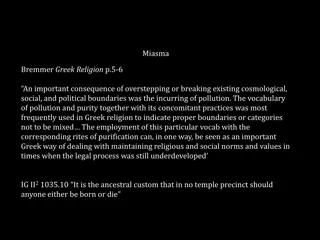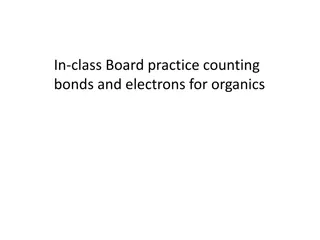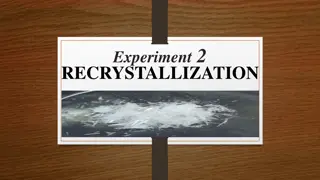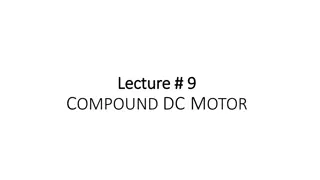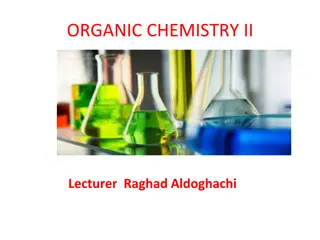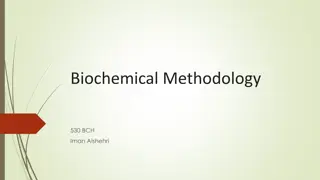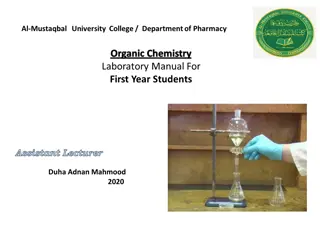Recrystallization for Solid Organic Compound Purification
Recrystallization is a laboratory technique used to purify solids based on their different solubilities. It involves dissolving an impure solid in a suitable solvent, cooling the solution to allow pure crystals to form, filtering to isolate the purified solid, and drying it. Finding a good recrystallization solvent entails testing the compound's solubility in various solvents like water, methanol, ethanol, and more common options. The chosen solvent should be highly soluble at its boiling point, non-reactive with the compound, easily removable, non-toxic, and cost-effective.
Download Presentation

Please find below an Image/Link to download the presentation.
The content on the website is provided AS IS for your information and personal use only. It may not be sold, licensed, or shared on other websites without obtaining consent from the author.If you encounter any issues during the download, it is possible that the publisher has removed the file from their server.
You are allowed to download the files provided on this website for personal or commercial use, subject to the condition that they are used lawfully. All files are the property of their respective owners.
The content on the website is provided AS IS for your information and personal use only. It may not be sold, licensed, or shared on other websites without obtaining consent from the author.
E N D
Presentation Transcript
Purification of solid organic compound by Recrystallization
Recrystallization is a laboratory technique used to purify solids based on their different solubilities. A small amount of solvent is added to a flask containing an impure solid. The contents of flask are heated until the solid dissolves. Next, the solution is cooled. A more pure solid precipitates, leaving impurities dissolved in the solvent. Vacuum filtration is used to isolate the crystals. The waste solution is discarded.
The steps in the recrystallization compounds are: Find a suitable solvent for the recrystallization. Dissolve the impure solid in a minimum volume of hot solvent. Remove any insoluble impurities by filtration. Slowly cool the hot solution to crystallize the desired compound from the solution. Filter the solution to isolate the purified solid compound and then dry it.
How to find a good recrystallizating solvent Assume that you have unknown compound and you want to purify it by recrystallization. First, determine its solubility properties in simple available solvents. It is usual to try water, methanol, ethanol, acetic acid, and less commonly ethyl acetate, acetonitrile and benzene.
Choosing a solvent: Asuitable solvent for recrystallization has the following properties: The compound should be very soluble at the boiling point of the solvent and low soluble in the solvent at room temperature. The solvent should not react with the compound being purified. The solvent should be volatile enough to be easily removed from the solvent after the compound has crystallized. The solvent should be non toxic, inflammable and low cost. Melting point: it is temperature at which the solid substance changes to liquid.
procedure Heat the hot plate to 110-130 C. place 100 ml of water in a 250 ml beaker and bring to a boil. Place approximately 1.0 g of impure benzoic acid in a 250 ml flask and add approximately 25 ml of hot water. If your sample appears to have an unwanted color, it can be removed later with charcoal. Heat the mixture on a hot plate until the water boils. Remove the flask from the hot plate and allow to cool down about 10 C before adding decolorizing charcoal. Decolorizing charcoal is usually added to remove colored impurities.
Using decolorizing carbon: Colored impurities are sometimes difficult to remove from solid mixtures. These colored impurities, often due to the presence of polar or polymeric compounds, can cause a colorless organic solid to have a tint of color even after recrystallization. Decolorizing or activated carbon is used to remove the colored impurities from the sample. Decolorizing carbon is very finely divided carbon that provides high surface area to adsorb the colored impurities.
Place the solution containing the charcoal back on the hot plate and boil for 5 minutes. Remove any solid insoluble impurities by using the technique of gravity filtration. Cool the filtered benzoic acid solution in an ice bath. Then filter the crystals on a Buchner funnel and wash the flask and crystals with a small amount of ice-cold water. Dry the crystals overnight.










